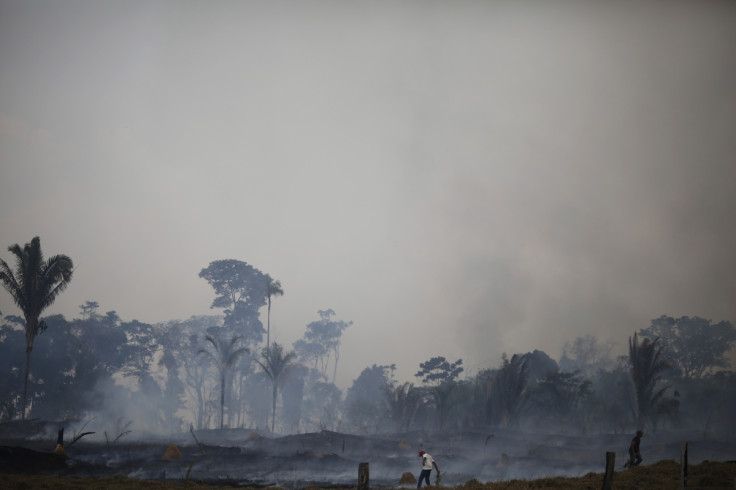El Niño fires are raging in the Amazon – and we're right in the middle of them

Erika Berenguer, Lancaster University and Jos Barlow, Lancaster University
As world leaders meet in Paris to tackle carbon emissions, here in the Amazon we are watching forests burning unchecked, releasing carbon into the atmosphere, destroying sensitive ecosystems and making breathing difficult.
There are forests fires in the Amazon every year, but 2015 is exceptional. We've been investigating the issue in the rainforest around Santarém, a city on the south bank of the Amazon, 800km from the sea. For the past five weeks we have woken up under a thick veil of smoke. For days we are barely able to see the sun. On many days last week visibility was less than 50 metres and the sun, once yellow, would rise red – if at all.
Even our clothes and our hair smell constantly of smoke. We have been living in the middle of a 24-hour barbecue in the middle of the world's largest tropical forest.
The El Niño phenomenon is contributing to this year's increased temperatures and changes in rainfall patterns, which means a more intense dry season across large swathes of the usually-humid tropics. Widespread fires in south-east Asian peatland forests have released huge amounts of smoke and made the air so polluted that Indonesia set up evacuation ships for affected people. These fires are estimated to have emitted more carbon in just a few weeks than the entire German economy over a whole year.
Satellite data shows the latest fires (left side, red dots) and the distribution of carbon monoxide from smoke (right).
Brazilian Institute of Space Research (INPE)
Although fires in the Amazon region have attracted much less attention than in Indonesia the situation is still alarming. In November alone, the Brazilian Amazon experienced 18,716 fires according to satellite data. They are are mainly started by farmers to clear areas of fallow or to get rid of weeds in pastures. However, planned fires often escape the targeted area, invade surrounding forests and burn the vegetation.
Rainforests aren't used to fire
These escaped fires may appear small and harmless but rainforests, unlike savannahs or temperate forests, have not co-evolved with periodic fires. This makes them particularly vulnerable. As a result, human-induced fires can kill up to 50% of the larger trees and most of the small-stemmed ones.
The authors visit the aftermath of a recent fire in the Amazon.
We still don't know how long it takes for a tropical rainforest to recover from fires, both in terms of biomass and biodiversity – they might never be able to regain their former glory. This is exactly one of the aims of the joint UK-Brazil research project that has brought us to the Amazon.
What we do know is that all those dead trees open a number of gaps in the forest canopy, which allow more light and wind to reach the forest floor. The forest then becomes hotter and drier and more prone to burn once again.
Fires are also used to burn the downed forest, so newly deforested areas can be cleared of all remaining vegetation and used for agriculture. When only one hectare of forest, an area equivalent to that of a football pitch, is chopped down and burned, roughly 300 tonnes of carbon are lost. In terms of carbon dioxide emissions, this is the same as a new car going around the world 61 times.
This all adds up. In the past year, 583,100 hectares of the Brazilian Amazon were deforested. That's a lot of cars.
The results of slash and burn.
Erika Berenguer, Author provided
The smoke and fires have made life very uncomfortable. Yet for local people there is no escape. The smoke cloud that daily covers the region has serious consequences for human health, which led 12 Amazonian cities to declare a state of emergency back in October. Task forces have been assigned to combat fires, but resources are thin and the region is too vast. Almost all fires are left to burn themselves out.
This year's El Niño has shown how vulnerable the world's largest tropical forest can be to extreme droughts. And recent forecasts have shown that such events are likely to triple by 2100. If 2015 can be used as an example, we are to expect more forest fires and much greater carbon emissions from tropical forest countries.
If world leaders at the UN climate conference are serious about limiting global warming to 2°C, they must learn from this hazy present, acting immediately to protect the remaining forested areas in the humid tropics. Otherwise, we can expect a fiery future.
Erika Berenguer, Senior Research Associate, Lancaster Environment Centre, Lancaster University and Jos Barlow, Professor of Conservation Science, Lancaster University
This article was originally published on The Conversation. Read the original article.
© Copyright IBTimes 2025. All rights reserved.






















